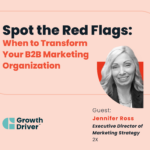It’s time we talk about something that’s been quietly holding us back—the MQL (Marketing Qualified Lead) model. The MQL has been around for over two decades, originally born out of the revenue waterfall model. But guess what? The way buyers buy has dramatically changed, yet many organizations still cling to this relic of the past. Why is that, and more importantly, how can we convince decision-makers to make the switch to a more modern approach like buying groups?
We asked Terry Flaherty, one of the original creators of the revenue waterfall model where the MQL was born, for his insights and advice to acknowledge the changes in B2B buyer behavior and make the transformation away from MQLs.
The Evolution of Buying Behavior
Remember the days when buyers were single entities, easily isolated and targeted by marketing campaigns? Yeah, those days are long gone. Today, B2B purchasing decisions are made by buying groups, not individuals. These groups comprise multiple stakeholders, each with their own perspectives, needs, and influence on the final decision. The MQL model, based on tracking individual leads, simply doesn’t align with this reality. It’s like using a landline in the era of smartphones—outdated and inefficient.
MQLs Are Old Playbook
Let’s be real here. The MQL model is an artifact from a time when marketing and sales operated in silos. This is characteristic of the old playbook. It doesn’t support the collaborative, multi-dimensional nature of today’s buying processes. Here’s why:
- Single-Lead Focus: MQLs track individual leads, failing to recognize the collective nature of buying groups.
- Misaligned Metrics: The metrics used to qualify MQLs often don’t reflect the true potential of an account.
- Fragmented Approach: By focusing on individual leads, the MQL model overlooks the bigger picture, leading to disjointed strategies and missed opportunities.
The Buying Group Advantage
Switching to a buying group approach is like upgrading from a flip phone to a smartphone. It’s a game-changer. Buying groups look at the entire account, considering all stakeholders involved in the decision-making process. This holistic view aligns sales and marketing efforts, ensuring a cohesive strategy that speaks to the needs of the entire group.
Benefits of the Buying Group Model
Terry says an essential element of making the switch to buying groups is a mindset shift away from disqualifying leads from the same account. “We need to recognize when we have an additional person from this account showing interest, it’s viewed as a celebration as opposed to a penalty that we’re getting multiple people engaged.”
- Holistic Insight: Understand the dynamics of the entire account, not just individual leads.
- Aligned Strategies: Create unified strategies that resonate with all stakeholders in the buying group.
- Better Engagement: Engage with multiple influencers within an account, increasing the chances of closing the deal.
Breaking the Cultural Barrier
If switching to buying groups is so beneficial, why aren’t more organizations making the change? Culture. And it’s culture coming from the top.
In reality, the top doesn’t care about MQLs. What they’re really concerned and interested about business impact. If we’re going to change culture from the top, that’s how we can change culture. Here’s how to convince them to make the switch:
1. Illustrate the Impact
Terry shared that his clients–brand-name, Fortune 50 companies– have seen anywhere from 25% to 400% increase in conversion rates after switching from the MQL model to buying groups.
The way to sell that to the C Suite or the Board is, “Would you like to give me a 25% increase in my demand budget? Or, would you like to make this culture and process change, and get the same 25% increase in ultimate conversions?”
2. Educate and Inform
To ensure this shift doesn’t disrupt alignment, start by educating your team about the limitations of the MQL model and the benefits of the buying group approach. Use data and case studies to illustrate the positive impact of this shift.
Remind them that the end goal of marketing should never ever be to hand off a single person. The end goal is an engaged buying group that your GTM team is collaborating on across marketing, sales, BDR–all the way to ultimately get a closed-won.
Embrace Buying Groups
The MQL model served its purpose in a different era, but it’s time to move on. Today’s B2B landscape demands a more holistic, account-based approach that recognizes the complexity of modern buying groups. By highlighting the long-term business impact, educating your GTM team, and properly leveraging technology, you can successfully transition to a buying group model and unlock new levels of efficiency and effectiveness in your sales and marketing strategies.
Ready to make the switch? Join us and countless other forward-thinking organizations in saying goodbye to MQLs and hello to a more integrated, modern approach to B2B sales.
Tune in to the full episode with Terry Flaherty–available wherever you watch or listen.
Apply for a tailored ICP Analysis
A precise ICP not only allows you to target more effectively, but enables internal alignment so that when buying teams are ready to engage, their experience is cohesive across marketing, sales, and customer success. Apply for a tailored ICP analysis—followed by an in-depth ICP workshop—to build your winning ICP so you can confidently target the right accounts with efficiency.



